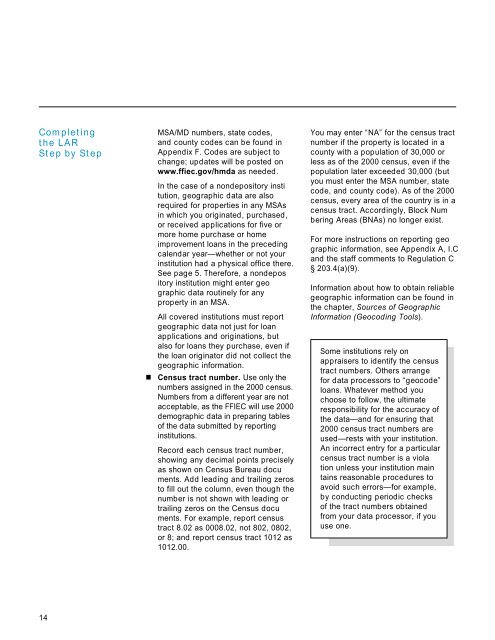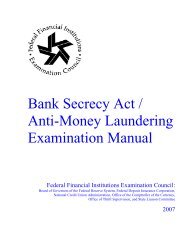A Guide to HMDA Reporting - ffiec
A Guide to HMDA Reporting - ffiec
A Guide to HMDA Reporting - ffiec
Create successful ePaper yourself
Turn your PDF publications into a flip-book with our unique Google optimized e-Paper software.
Completing MSA/MD numbers, state codes,<br />
the LAR<br />
and county codes can be found in<br />
Step by Step<br />
Appendix F. Codes are subject <strong>to</strong><br />
change; updates will be posted on<br />
www.<strong>ffiec</strong>.gov/hmda as needed.<br />
14<br />
In the case of a nondeposi<strong>to</strong>ry institution,<br />
geographic data are also<br />
required for properties in any MSAs<br />
in which you originated, purchased,<br />
or received applications for five or<br />
more home purchase or home<br />
improvement loans in the preceding<br />
calendar year—whether or not your<br />
institution had a physical office there.<br />
See page 5. Therefore, a nondeposi<strong>to</strong>ry<br />
institution might enter geographic<br />
data routinely for any<br />
property in an MSA.<br />
All covered institutions must report<br />
geographic data not just for loan<br />
applications and originations, but<br />
also for loans they purchase, even if<br />
the loan origina<strong>to</strong>r did not collect the<br />
geographic information.<br />
¢ Census tract number. Use only the<br />
numbers assigned in the 2000 census.<br />
Numbers from a different year are not<br />
acceptable, as the FFIEC will use 2000<br />
demographic data in preparing tables<br />
of the data submitted by reporting<br />
institutions.<br />
Record each census tract number,<br />
showing any decimal points precisely<br />
as shown on Census Bureau documents.<br />
Add leading and trailing zeros<br />
<strong>to</strong> fill out the column, even though the<br />
number is not shown with leading or<br />
trailing zeros on the Census documents.<br />
For example, report census<br />
tract 8.02 as 0008.02, not 802, 0802,<br />
or 8; and report census tract 1012 as<br />
1012.00.<br />
You may enter “NA” for the census tract<br />
number if the property is located in a<br />
county with a population of 30,000 or<br />
less as of the 2000 census, even if the<br />
population later exceeded 30,000 (but<br />
you must enter the MSA number, state<br />
code, and county code). As of the 2000<br />
census, every area of the country is in a<br />
census tract. Accordingly, Block Numbering<br />
Areas (BNAs) no longer exist.<br />
For more instructions on reporting geographic<br />
information, see Appendix A, I.C<br />
and the staff comments <strong>to</strong> Regulation C<br />
§ 203.4(a)(9).<br />
Information about how <strong>to</strong> obtain reliable<br />
geographic information can be found in<br />
the chapter, Sources of Geographic<br />
Information (Geocoding Tools).<br />
Some institutions rely on<br />
appraisers <strong>to</strong> identify the census<br />
tract numbers. Others arrange<br />
for data processors <strong>to</strong> “geocode”<br />
loans. Whatever method you<br />
choose <strong>to</strong> follow, the ultimate<br />
responsibility for the accuracy of<br />
the data—and for ensuring that<br />
2000 census tract numbers are<br />
used—rests with your institution.<br />
An incorrect entry for a particular<br />
census tract number is a violation<br />
unless your institution maintains<br />
reasonable procedures <strong>to</strong><br />
avoid such errors—for example,<br />
by conducting periodic checks<br />
of the tract numbers obtained<br />
from your data processor, if you<br />
use one.
















